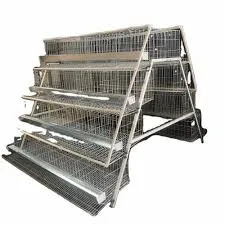Battery cages are widely using in modern poultry farming for their efficient use of space, ease of management, and improved bird welfare. They are usually categorized into two main types: A-type and H-type battery cages. While both types share similar purposes, they have distinct differences that impact their suitability for various poultry farming operations. Understanding these differences is essential for poultry farmers to make informed choices when selecting the appropriate battery cages for their specific needs.
1. Poultry Farming Battery Cage Structure
A-Type Battery Cages
- The A-type battery cage has a simple and open design, featuring a triangular-shaped frame that resembles the letter “A.”
- It consists of several tiers stacked one above the other, with each tier housing multiple birds.
- The birds have access to the entire width of the cage, allowing them to move freely and engage in natural behaviors such as scratching and perching.

H-Type Battery Cages
- The H-type battery cage is a more complex and enclosed structure, resembling the letter “H.”
- It is composed of two rows of cages facing each other, with a central aisle running in between.
- Each row of cages is divided into compartments, with each compartment accommodating a single bird.
- The birds are confined to their respective compartments and have limited space for movement.
2. Difference in The Number of Spaces Between A-type and H-type Battery Cages
A-Type Battery Cages
- A-type battery cages typically allow for a higher bird density compared to H-type cages.
- Due to their open design and larger cage space, A-type cages can accommodate more birds per unit area.
- This higher bird density can lead to increased egg production and revenue, but it also requires more careful management and attention to bird welfare.
H-Type Battery Cages
- H-type battery cages have a lower bird density due to their more confined design.
- The limited space in each compartment restricts the number of birds that can be housed together.
- This lower bird density can help reduce the risk of disease transmission and improve bird welfare, but it may result in lower egg production and revenue.
3.Difference in Egg Collection of A-type and H-type Battery Cages
A-Type Battery Cages:
- Egg collection in A-type battery cages is typically done manually or through the use of automated systems.
- Workers or automated devices reach into the cages to collect the eggs laid by the birds.
- The eggs are usually gathered in trays or conveyor belts for further processing and packaging.

H-Type Battery Cages:
- H-type battery cages have a more automated egg collection system.
- The eggs roll down a sloped floor in each compartment and are collected in a central egg-gathering belt.
- This automated system minimizes the need for manual labor and reduces the risk of egg breakage during collection.
H type 3 or 4 tiers broiler chicken cage
4.Difference in Feeding and Watering Systems of A-type and H-type Battery Cages
A-Type Battery Cages:
- A-type battery cages typically employ trough feeders that run along the length of the cage.
- These feeders are filled with feed, and the birds can access them from inside the cage.
- Water is provided through nipple drinkers, which are suspended from the top of the cage.
H-Type Battery Cages:
- H-type battery cages often use a more sophisticated feeding system.
- Feed is delivered to each compartment through automated feed dispensers, ensuring that each bird has access to a consistent supply of feed.
- Water is also provided through nipple drinkers, which are located within each compartment.
5.Difference in Manure Management of A-type and H-type Battery Cages
A-Type Battery Cages:
- A-type battery cages typically have a manure belt or scraper system for manure removal.
- The manure belt runs beneath the cages, collecting the droppings and transporting them to a centralized location for disposal.
- Alternatively, a scraper system may be used to push the manure out of the cage into a collection pit.
H-Type Battery Cages:
- H-type battery cages often employ a deep pit manure management system.
- The manure falls through the slatted floor of the cages into a deep pit beneath.
- The manure is periodically removed from the pit using mechanical or hydraulic systems for proper disposal.

6. Cost of A-type and H-type Battery Cages
A-Type Battery Cages:
- A-type battery cages are generally more economical to purchase and install compared to H-type cages.
- They require less complex infrastructure and maintenance.
- However, the higher bird density in A-type cages may necessitate additional management efforts to ensure adequate ventilation, sanitation, and bird welfare.
H-Type Battery Cages:
- H-type battery cages involve a higher initial investment due to their more sophisticated design and automated features.
- They require specialized equipment and regular maintenance to ensure proper operation of the feeding, watering, and egg collection systems.
- The lower bird density in H-type cages may reduce the labor costs associated with bird management and disease control.
Conclusion
A-type and H-type battery cages offer distinct advantages and disadvantages for poultry farming. A-type cages provide higher bird density and lower initial investment but require meticulous management and attention to bird welfare. H-type cages offer improved automation, reduced labor costs, and better control over bird density and hygiene but involve a higher upfront cost. Ultimately, the choice between A-type and H-type battery cages depends on the specific requirements, scale, and budget of the poultry farming operation. Poultry farmers should carefully consider these factors to select the battery cage system that best suits their individual needs and ensures optimal bird welfare and productivity.







